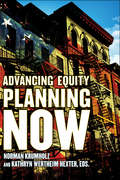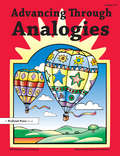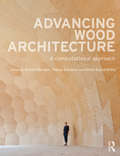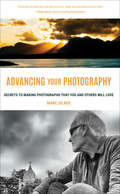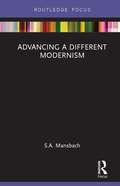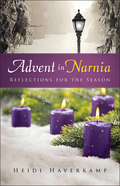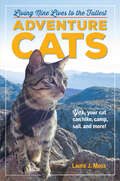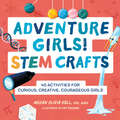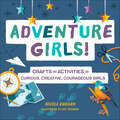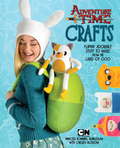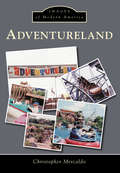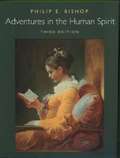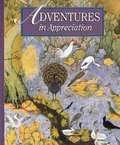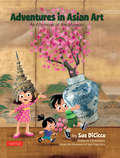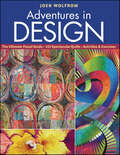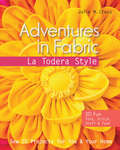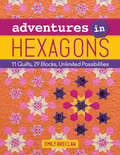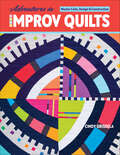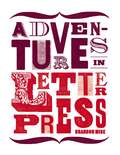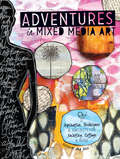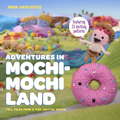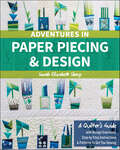- Table View
- List View
Advancing American Art: Painting, Politics, and Cultural Confrontation at Mid-Century (Second Edition)
by Leon F. Litwack Maltby Sykes Taylor D. LittletonA representative collection of avant-garde American painting from the 1930s and ’40s, owned by Auburn University. Conceived and funded by the State Department in 1946 as part of a new emphasis in international diplomacy, the exhibit of paintings called Advancing American Art was launched on what was enthusiastically projected as an extended goodwill tour of Europe and Latin America. But almost immediately the exhibit was attacked by conservative groups as “un-American” and “subversive” and its abstract paintings ridiculed in the national media, in Congress, and by no less a critic than President Truman. Following their recall by Secretary Marshall in 1947, the exhibit’s paintings were quietly declared surplus property and sold under rather curious circumstances by the War Assets Administration. Most of the collection was acquired by a small number of public universities in what could be called the art bargain of the century, since works by such figures as Marin, O’Keefe, Shahn, Dove, Kuniyoshi, and Hartley were sold for $100 or less. The chronicle of this exhibit tells us something about America after the war, when the nation sought to reconcile its sacrificial experiences from the Depression and in World War II with its new role on the international scene. Defining the figures of confrontation that challenged America’s tenuous self-conceptions at the time, this book captures a significant transitional moment in U.S. history while also serving as a catalog of the 38 masterpieces purchased by Auburn University.
Advancing Equity Planning Now
by Edited by Norman Krumholz and Kathryn Wertheim HexterWhat can planners do to restore equity to their craft? Drawing upon the perspectives of a diverse group of planning experts, Advancing Equity Planning Now places the concepts of fairness and equal access squarely in the center of planning research and practice. Editors Norman Krumholz and Kathryn Wertheim Hexter provide essential resources for city leaders and planners, as well as for students and others, interested in shaping the built environment for a more just world.Advancing Equity Planning Now remind us that equity has always been an integral consideration in the planning profession. The historic roots of that ethical commitment go back more than a century. Yet a trend of growing inequality in America, as well as other recent socio-economic changes that divide the wealthiest from the middle and working classes, challenge the notion that a rising economic tide lifts all boats. When planning becomes mere place-making for elites, urban and regional planners need to return to the fundamentals of their profession. Although they have not always done so, planners are well-positioned to advocate for greater equity in public policies that address the multiple objectives of urban planning including housing, transportation, economic development, and the removal of noxious land uses in neighborhoods.Thanks to generous funding from Cleveland State University, the ebook editions of this book are available as Open Access volumes from Cornell Open (cornellopen.org) and other repositories.
Advancing Through Analogies: Grades 5-8
by Lynne ChathamYou can easily build your students' critical thinking and vocabulary skills with these fun analogy activities. Teaching students to solve analogies not only develops analogical thinking, but it also helps students learn and apply vocabulary skills. An analogy is a comparison between two things. It points out the similarities or likenesses between things that might be different in all other respects.The exercises included in this resource not only build thinking skills and make students more flexible and analytical, but they also enhance vocabulary and writing skills. Each illustrated page presents several analogy types along with examples of each type. Review pages give students an opportunity to identify and then solve a variety of analogies. The activities in this book will challenge students to think more critically and apply advanced vocabulary.This book introduces 16 different types of analogies, including: synonyms (calm : serene),part to whole (ring : jewelry),place or location (Peru : South America),cause and effect (fire : smoke),action to object (cut : scissors), andcharacteristics (ruby : red). These challenging activities are perfect for teaching analytical thinking, enhancing vocabulary, and improving writing skills. Advancing Through Analogies is the most advanced book in a series from Prufrock that introduces analogies to young thinkers. While the activity books in the series for younger students emphasize visual and symbolic analogies, this book for older students emphasizes verbal analogies. For easier analogies, see Thinking Through Analogies, Analogies for the 21st Century, Analogies for Beginners, and First Time Analogies. Grades 5-8
Advancing Wood Architecture: A Computational Approach
by Achim Menges Tobias Schwinn Oliver David KriegIn light of environmental challenges architecture is facing, wood is no longer regarded as outmoded, nostalgic, and rooted in the past, but increasingly recognized as one of the most promising building materials for the future. Recent years have seen unprecedented innovation of new technologies for advancing wood architecture. Advancing Wood Architecture offers a comprehensive overview of the new architectural possibilities that are enabled by cutting-edge computational technologies in wood construction. It provides both an overarching architectural understanding and in-depth technological information through built projects and the works of four leading design research groups in Europe. The projects presented include large scale, permanent buildings such as the ETH Arch-Tec Lab Building in Zurich, the Landesgartenschau Exhibition Hall near Stuttgart and the Boiler House in Hooke Park, UK, as well as, built research prototypes investigating additive robotic fabrication, folded plate structures and meteorosensitive building skins. Illustrated in full colour, the book showcases the latest technological developments in design computation, simulation and digital fabrication together with an architectural, engineering and manufacturing perspective, offering an outlook towards novel spatial and constructional opportunities of a material with unrivalled ecological virtues.
Advancing Your Photography: Secrets to Making Photographs that You and Others Will Love
by Marc SilberThe author of Create presents &“an all-in-one, easily accessible handbook . . . [that] will show you how the pros do it. Study this and take your best shot&” (Chase Jarvis, award-winning photographer). In Advancing Your Photography, Marc Silber provides the definitive handbook that will take you through the entire process of becoming an accomplished photographer. From teaching you the basics to exploring the stages of the full &“cycle of photography,&” Silber makes it easy for you to master the art form and create stunning pictures. From thousands of hours of interviews with professional photography masters, you will learn valuable insights and tips on beginner, amateur, landscape, wedding, lifestyle, sports, animal, portrait, still life, and iPhone photography. Advancing Your Photography features: · Top tips for making outstanding photographs from iconic photographers and many other leading professional photography masters of today · Numerous step-by-step examples · Guidance on training your eye to see composition with emotional impact · Tips on mastering the key points of operating your camera like a pro · Secrets to processing your images to professional standards Photography and the technology associated with it are constantly evolving, but the fundamentals remain the same. Advancing Your Photography will help to bring you the joy and satisfaction of a lifetime of pursuing the art of photography.
Advancing a Different Modernism (Routledge Focus on Art History and Visual Studies)
by S.A. MansbachAdvancing a Different Modernism analyzes a long-ignored but formative aspect of modern architecture and art. By examining selective buildings by the Catalan architect Lluís Domènech i Montaner (1850-1923) and by the Slovenian designer Jože Plecnik (1872-1957), the book reveals the fundamental political and ideological conservatism that helped shape modernism’s history and purpose. This study thus revises the dominant view of modernism as a union of progressive forms and progressive politics. Instead, this innovative volume promotes a nuanced and critical consideration of how architecture was creatively employed to advance radically new forms and methods, while simultaneously consolidating an essentially conservative nationalist self-image.
Advent in Narnia: Reflections for the Season
by Heidi Haverkamp"Walking into Advent can be like walking through the wardrobe. " With its enchanting themes of snow and cold, light and darkness, meals and gifts, temptation and sin, forgiveness and hope--and even an appearance by Father Christmas--C. S. Lewis's The Lion, the Witch, and the Wardrobe fits naturally into the Advent season. As the reader seeks a storied king and anticipates the glorious coming of Christmas, these twenty-eight devotions alternate between Scripture and passages from the novel to prompt meditation on Advent themes. Each devotion also includes questions for reflection. The book also provides several resources for churches, including four sessions for small group discussion and ideas for creating a "Narnia Night" for families. Readers will ultimately come to know God better while journeying through Narnia.
Adventure Cats: Living Nine Lives to the Fullest
by Laura J. MossJust when you thought you knew all there was to know about cats comes the ultimate—and unexpected—guide to taking your cat into the wild. Here are cats walking on a leash. Cats hiking on a leash. Cats tramping through snow. Cats camping. Cats kayaking, canoeing, even surfing—yes, cats who love water. When animal writer and active hiker Laura Moss couldn’t find an online resource for hitting the trail with her cat, she created one. AdventureCats.org took off like wildfire, with attention from Wired, the Huffington Post, Outside magazine, BuzzFeed, and much more. Now, the book Adventure Cats—a collection of jaw-dropping photographs, inspiring stories of real-life cats, and all the how-to a cat owner needs—will take readers and their cats well beyond the backyard. Learn how to leash-train a cat. What to do if you encounter wildlife on the trail. Plus, winter safety tips, and how to bring a little bit of the outdoors to an indoor cat. The stories themselves are catnip for animal lovers, from Nanakuli, the one-eyed cat who hangs ten; to Georgie, a four-year-old gray tabby who lives on a sailboat; to Quandary, who not only insists on hiking with her family but also teaches them a valuable lesson: When you follow your cat’s natural tendency to wander, you experience the outdoors at a slower, richer pace. This book will delight every cat person, regardless of whether their pet is inclined to adventure. (Take the quiz at the beginning of the book to find out!)
Adventure Girls! STEM Crafts: 40 Activities for Curious, Creative, Courageous Girls (Adventure Crafts for Kids)
by Dr. Megan Olivia Hall PhD, MEdInspire girls to build and create with fun, hands-on STEM crafts for ages 6 to 12 The world needs adventurous girls to lead the way to a brighter future! Help them discover new things about science, technology, engineering, and math (STEM) with this collection of engaging crafts for girls. As they learn and have fun with each project, they'll boost their critical-thinking skills, creativity, and self-confidence, too. What sets this book of STEM crafts apart: No parents required!—Encourage independence with arts & crafts that can be made with basic household materials and include kid-friendly, step-by-step instructions. Skill-building projects—Every project, from creating a Newton's cradle to knitting a DNA garland, incorporates basic STEM principles to help curious girls learn more about the world around them. Adventure girl challenges—Bonus activities and fun facts sprinkled throughout the book will inspire girls to dive deeper into the concepts and skills they're learning. Help girls have a blast discovering the secrets of the STEM universe through educational crafts for kids.
Adventure Girls!: Crafts and Activities for Curious, Creative, Courageous Girls (Adventure Crafts for Kids)
by Nicole DugganExplore, create, and imagine like a girl!Girls can do anything, and Adventure Girls! proves it! Packed with exciting activities and crafts for girls (ages 6 to 12), this book inspires young adventurers to be curious, innovative, and bold. From stargazing and animal tracking to making a pinhole camera and building a shadow theater, Adventure Girls! is not one of your typical craft books. It empowers girls to:Develop independence—Many of the activities are designed to be parent-assisted as girls learn to explore and create safely on their own.Delve into science—Discover scientific ideas and principles through constellation identification, bird watching, and compass making.Get their hands dirty—Adventure Girls! encourages outdoor play and exploration, from making a rope swing in the backyard to going on a nature scavenger hunt to building a shelter outside.Express their creative side—These crafts for girls also engage their artistic side, with activities like creating decorative 3D stars, pressing flowers, and folding (and inventing their own) paper airplanes.Instill confidence and curiosity with this collection of fun, engaging activities and crafts for girls.
Adventure Time Crafts
by Cartoon Network Chelsea BloxsomWith Jake the dog and Finn the human, the crafts will never end! Learn how to stitch, paint, sculpt, and crochet more than 23 projects featuring your favorite Adventure TimeTM characters. You'll find designs by fans just like you for plush toys, chic jewelry, crafty home decor, and stylish fashions straight from the Candy Kingdom:* Reversible Jake/Cake Plush* Marceline's Axe* Bubblegum's Like-Like Sweater* Peppermint Butler Pillow* Oh My Glob, Nail Art!* Fionna and Finn Hats* BMO's 8-Bit Fuse Bead CoastersAnd so much more! What the lump are you waiting for? It's time to D.I.Y.!
Adventureland
by Christopher MercaldoSince 1962, Adventureland has been entertaining and thrilling the Long Island community. The park was constructed in a rural area of Suffolk County around the time of a suburban boom eastward on Long Island, which brought enormous population growth in Nassau and Suffolk Counties. Since its opening, the park has seen significant change, with numerous rides and attractions being moved or retired to make way for newer attractions. Published here are images of the park throughout its entire history, many of which have never been seen by the public before. Adventureland shares early lost attractions and retired fan favorites in full living color, allowing both the young and the young at heart to remember the park in all of its stages, from opening to today.
Adventures In The Human Spirit (Third Edition)
by Philip E. BishopExceptionally student-friendly, extensively illustrated, and engagingly thought-provoking, this one-volume historical survey of the humanities is accessible--and inviting--to readers with little background in the arts and humanities. Carefully balanced among the major arts, philosophy, and religion and finely focused on selected principal events, styles, movements, and figures, it brings the past to life by including authentic documents from daily life, comparative global perspectives, and examples from literature, philosophy, music--including the contributions of women and minority artists. For individuals waiting to discover the humanities' rich connections to their own
Adventures in Appreciation (Athena Edition)
by Carroll Moulton Glenda Zumwalt William BassellThe book is a collection of poems, stories, dramas and biographies from different books. It has questions at the end of each section, breaks down the process of essay writing and also defines some vocabulary at the end of each illustration.
Adventures in Asian Art: An Afternoon at the Museum
by Sue DiciccoRide on a rhino, become a samurai, or climb Mt. Fuji! Asia is an entire world of wonderful places to go and things to see and do!Exploring other cultures is a favorite classroom activity for teachers and students alike. Now, author Sue DiCicco draws on her background as a writer, illustrator, sculptor, and former Disney animator to take kids on an imaginative tour of China, Japan, Korea, India, and beyond through artifacts on display at the Asian Art Museum in San Francisco.Adventures in Asian Art travels from exhibit to exhibit, inviting kids to picture themselves in a variety of Asian countries as they ride on a rhino, become a samurai, or climb Mt. Fuji! Asia is home to an endless array of wonderful places to go and things to see and do, and through the magic of DiCicco's charming verse narrative, readers join a cartoon mom as she takes her three cartoon children through the museum for an afternoon of nonstop fun and learning.This delightfully illustrated, classroom-friendly book shares a series of fun facts about each of the exhibits and explains the culture, beliefs, and daily life informing these wonderful works of art.
Adventures in Cartooning: Create a World (Adventures in Cartooning #3)
by Alexis Frederick-Frost James Sturm Andrew ArnoldIn this long-awaited third volume in Adventure in Cartooning series, you’ll find everything you need to dream up and draw fantastical worlds for your character to inhabit!The Knight is back and ready for another cartooning adventure with Edward the Horse! As every adventurer knows, you can’t have an epic journey without an epic new world to explore. They could fly to a floating metropolis or swim through an underwater empire, trek across a frozen tundra or climb to the top of a majestic mountain—the possibilities are endless! But before they do, they’ll need to draw it first. Luckily for them, the Magical Cartooning Elf is ready to help, with brand-new tips and tricks that will turn simple drawings into boundless worlds.
Adventures in Design: The Ultimate Visual Guide, 153 Spectacular Quilts, Activities & Exercises
by Joen WolfromBring more beauty and balance to your quilt designs • Everything you need to know about the essentials of good design from an internationally reknowned expert • Learn about the key elements of design and how to apply strategies for success • Practice what you've learned with exercises at the end of each chapter • An inspiring gallery illustrates design concepts by many prominent quilters and artists - including Alex Anderson, Paula Nadelstern, and Ricky Tims - with over 150 images showcasing all styles of quilts and fabric art, from traditional to modern This is the design textbook for quilters. Joen presents the eight elements of design: line, direction, shape, color, value, texture, proportion, and scale. You'll learn how to work with these elements using many guiding design principles, such as unity and balance. Whether you consider yourself to be a quilter, an artist, or a crafter, you can improve your design skills by exploring Joen's fresh, innovative approach.
Adventures in Fabric: La Todera Style
by Julie M. CreusLearn creative new techniques for 3-D fabric creations with this guide featuring 20 fun and colorful projects from the designer behind La Todera.This festive collection from designer Julie Creus brings together bright fabrics, ingenious construction methods, and a large dash of whimsy to make 3-D effects like you've never seen before in fabric. Create usable art with new techniques for fabric folding, fusing, weaving, and thread wrapping. Julie Creus shares step-by-step instructions for 20 truly unique projects—including brooches, pillows, table decor, sewing accessories, holiday decorations, children's softies, and more. These scrap-friendly projects are usable, beautiful, and fun to make. Julie's inventive methods make the sewing easy, whether you are a beginning or expert sewist.
Adventures in Hexagons: 11 Quilts, 29 Blocks, Unlimited Possibilities
by Emily Breclaw“Expert step-by-step instructions to help you create a stunning quilt that will make your friends ask, ‘How did you do that?’” —Quilter’s ConnectionMove beyond one-patch hexagon layouts with eleven show-stopping hexie projects to stitch by hand or machine. Sew blocks in a variety of sizes and pieced combinations for stunning visual effects! You’ll master the Y-seam with a variety of techniques to cut and piece hexagons. Mix it up with the author’s design primer, which gives you the tools to draft your own unique hexie quilt layout.“Breclaw’s thoughtful instruction and logical processes for assembly will guide both beginners and experienced quilters.” —Library Journal
Adventures in Improv Quilts: Master Color, Design & Construction
by Cindy GrisdelaTake on color and creativity—discover three different ways to improv quilt, creating one-of-a-kind works of art. Find inspiration in Improv and start your journey with bold colors and unique designs! Improv expert Cindy Grisdela shares the design principles and construction strategies for successful quilts every time. Explore three different ways to create improvisationally, from the easiest―using one block in different colors and orientations―to combining block units using various techniques―to aspirational, free cutting the entire quilt and designing it on the wall before sewing. Finished creations result in one-of-a-kind artwork! · Master three different improvisational styles to create original works of art · Design and construction process made easy with expert strategies Guided exercises will have you creating stunning Improv quilts in no time
Adventures in Letterpress
by Brandon MiseTactile, retro and idiosyncratic, hand-printed objects have an undeniable appeal, especially in a digital age. In recent years, the nearly obsolete craft of letterpress has been resurrected by artists and designers who have rescued cast-iron presses from basements and scrap yards. Adventures in Letterpress features over 200 examples of the resulting work: elegant cards, edgy broadsheets and everything in between. Beautiful, humorous and sometimes just plain weird, the projects featured in the book perfectly illustrate the vibrant future of this once-endangered medium.
Adventures in Letterpress
by Brandon MiseTactile, retro and idiosyncratic, hand-printed objects have an undeniable appeal, especially in a digital age. In recent years, the nearly obsolete craft of letterpress has been resurrected by artists and designers who have rescued cast-iron presses from basements and scrap yards. Adventures in Letterpress features over 200 examples of the resulting work: elegant cards, edgy broadsheets and everything in between. Beautiful, humorous and sometimes just plain weird, the projects featured in the book perfectly illustrate the vibrant future of this once-endangered medium.
Adventures in Mixed Media Art: Inspiration, Techniques and Projects for Painting, Collage and More
by Amy JonesAre you inspired by mixed-media art but don't know where to start?Adventures in Mixed Media Art is the ultimate guidebook for embarking on your own creative adventure! Featuring 20 favorite mixed-media projects from the bestselling North Light backlist, this "best of the best" collection will motivate any would-be artist to start creating!Beginning with motivational readings, you will discover and learn to refine your creative energy by discovering what inspires you. Then you are ready to create your very own art journal using guided mixed-media techniques, including hand lettering and basic painting and collage techniques.When you're ready to create and refine your signature style, you'll start creating canvas paintings, collages and assemblage pieces based on projects from popular mixed-media artists like Dina Wakley, Mary Beth Shaw, and more. Even if your project doesn't turn out as planned, the book includes helpful tips and techniques for repurposing those pieces into a new work of art you can proudly display. The book also includes collaborative projects so you can encourage others to start their own Adventures in Mixed Media!
Adventures in Mochimochi Land
by Anna HrachovecWhat do a talking doughnut, a crabby politician, and a lovelorn balloon have in common? They're all citizens of the candy-colored knitted world known as Mochimochi Land. Adventures in Mochimochi Land started out as a collection of tiny knitted characters, but as the patterns grew they needed an entire world of their own, complete with knitted cities, knitted forests, knitted oceans, and most important, knitted friends! The book follows the adventures of a tiny knitted explorer, as he travels this unbelievably cute world and uncovers its strange yarn-based origins. For intrepid knitters, the book also includes a section with 25 all-new patterns for the characters and props used in the stories. The patterns use small amounts of yarn and beginner-friendly knitting skills and knit up quickly for instant fun.
Adventures in Paper Piecing & Design: A Quilter's Guide with Design Exercises, Step-by-Step Instructions & Patterns to Get You Sewing
by Sarah Elizabeth SharpTurn your interest in foundation paper-piecing into a full-blown love affair. Learn about every stage of the process—from piecing technique to pattern design—in this comprehensive guide. Start with the basics of sewing on paper, then explore the author’s open-ended design exercises to create your own patterns or follow along with the author’s take to sew her graphic interpretations of the prompts. With an annotated overview of the author’s favorite FPP methods, countless tips, and over thirty paper-pieced quilt blocks plus seven design exercises to put your skills to the test, you’ll have the tools you need to thrive when confronted with any paper-piecing challenge! - Build your piecing skills with over thirty graphic paper-pieced blocks inspired by everything from house plants to typography to surface pattern design techniques - Learn how to translate your own reference images or sketches into FPP patterns - Sharpen your pattern-design skills with choose-your-own-adventure style exercises "

